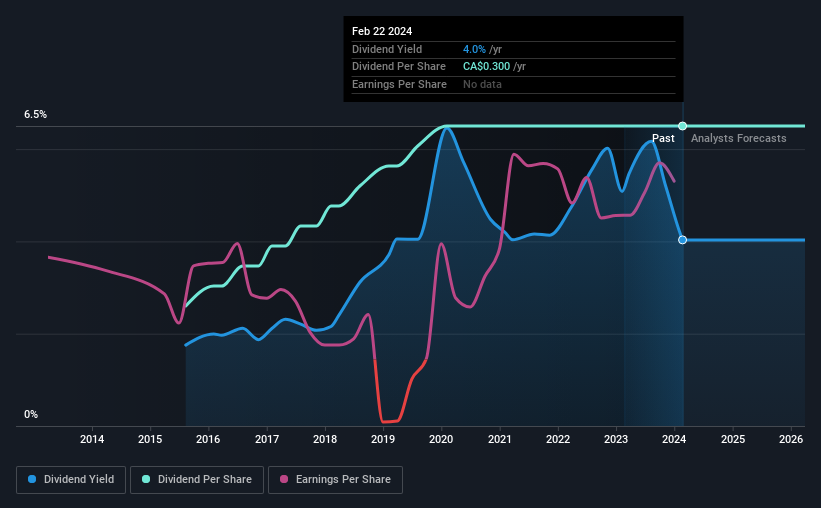Stingray Group Inc. (TSE:RAY.A) Looks Interesting, And It's About To Pay A Dividend
Stingray Group Inc. (TSE:RAY.A) is about to trade ex-dividend in the next 4 days. The ex-dividend date is one business day before the record date, which is the cut-off date for shareholders to be present on the company's books to be eligible for a dividend payment. The ex-dividend date is important because any transaction on a stock needs to have been settled before the record date in order to be eligible for a dividend. Meaning, you will need to purchase Stingray Group's shares before the 28th of February to receive the dividend, which will be paid on the 15th of March.
The company's next dividend payment will be CA$0.075 per share, and in the last 12 months, the company paid a total of CA$0.30 per share. Based on the last year's worth of payments, Stingray Group stock has a trailing yield of around 4.0% on the current share price of CA$7.44. We love seeing companies pay a dividend, but it's also important to be sure that laying the golden eggs isn't going to kill our golden goose! As a result, readers should always check whether Stingray Group has been able to grow its dividends, or if the dividend might be cut.
Check out our latest analysis for Stingray Group
Dividends are typically paid out of company income, so if a company pays out more than it earned, its dividend is usually at a higher risk of being cut. Stingray Group paid out 56% of its earnings to investors last year, a normal payout level for most businesses. Yet cash flow is typically more important than profit for assessing dividend sustainability, so we should always check if the company generated enough cash to afford its dividend. It paid out 24% of its free cash flow as dividends last year, which is conservatively low.
It's positive to see that Stingray Group's dividend is covered by both profits and cash flow, since this is generally a sign that the dividend is sustainable, and a lower payout ratio usually suggests a greater margin of safety before the dividend gets cut.
Click here to see the company's payout ratio, plus analyst estimates of its future dividends.
Have Earnings And Dividends Been Growing?
Companies with consistently growing earnings per share generally make the best dividend stocks, as they usually find it easier to grow dividends per share. If business enters a downturn and the dividend is cut, the company could see its value fall precipitously. That's why it's comforting to see Stingray Group's earnings have been skyrocketing, up 66% per annum for the past five years. The current payout ratio suggests a good balance between rewarding shareholders with dividends, and reinvesting in growth. With a reasonable payout ratio, profits being reinvested, and some earnings growth, Stingray Group could have strong prospects for future increases to the dividend.
Another key way to measure a company's dividend prospects is by measuring its historical rate of dividend growth. Stingray Group has delivered 11% dividend growth per year on average over the past nine years. Both per-share earnings and dividends have both been growing rapidly in recent times, which is great to see.
Final Takeaway
Should investors buy Stingray Group for the upcoming dividend? We like Stingray Group's growing earnings per share and the fact that - while its payout ratio is around average - it paid out a lower percentage of its cash flow. Overall we think this is an attractive combination and worthy of further research.
While it's tempting to invest in Stingray Group for the dividends alone, you should always be mindful of the risks involved. In terms of investment risks, we've identified 2 warning signs with Stingray Group and understanding them should be part of your investment process.
If you're in the market for strong dividend payers, we recommend checking our selection of top dividend stocks.
Have feedback on this article? Concerned about the content? Get in touch with us directly. Alternatively, email editorial-team (at) simplywallst.com.
This article by Simply Wall St is general in nature. We provide commentary based on historical data and analyst forecasts only using an unbiased methodology and our articles are not intended to be financial advice. It does not constitute a recommendation to buy or sell any stock, and does not take account of your objectives, or your financial situation. We aim to bring you long-term focused analysis driven by fundamental data. Note that our analysis may not factor in the latest price-sensitive company announcements or qualitative material. Simply Wall St has no position in any stocks mentioned.

